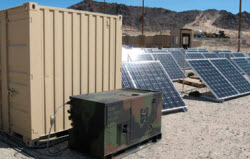Week in review: Spring kicks off new season of solar fun
 Last spring a number of companies in the U.S introduced new incentives and awards to get more people to go solar. It looks like that trend is continuing this year. Already at least one company has announced a giveaway of a photovoltaic (PV) array this summer and more are likely to follow. Meanwhile the adoption of solar is growing across the U.S. and one of the biggest supporters of renewable energy is actually turning out to be the military. And that’s just some of what happened last week.
Last spring a number of companies in the U.S introduced new incentives and awards to get more people to go solar. It looks like that trend is continuing this year. Already at least one company has announced a giveaway of a photovoltaic (PV) array this summer and more are likely to follow. Meanwhile the adoption of solar is growing across the U.S. and one of the biggest supporters of renewable energy is actually turning out to be the military. And that’s just some of what happened last week.
First off, Massachusetts residents that want to go solar may win a free PV array through Mercury Solar Systems. The company is offering a free PV array—up to 7 kilowatts—to a homeowner through a new solar sweepstakes. The sweepstakes is open to all Massachusetts residents, but there’s only one prize. It’s the first time that Mercury, an east coast solar installer, has offered a sweepstakes.
Then there’s Florida. Its largest utility, Florida Light & Power (FPL) announced that it will reopen its immensely popular incentive program, under which home and business owners can qualify for up to $20,000 in incentives for going solar. The past two times FPL has offered the incentives they’ve sold out within a day. That’s likely because the utility is offering $3.3 million in incentives under this round of financing.
Across the country, Los Angeles is moving forward with its feed-in tariff. The board of commissioners for the city’s utility, Los Angeles Department of Water and Power (LADWP), approved an 10 megawatt feed-in tariff (FiT) pilot that will help the utility meet California’s renewable portfolio standard requirements. Under the pilot, participants will receive a premium price for power produced by a photovoltaic system. The FiT pilot is part of a larger program that will support up to 100 megawatts of distributed generation in the so-called city of angels. However, the FiT is geared more towards businesses than homeowners, since systems between 30 kilowatts and 999 kilowatts can apply.
The world’s biggest energy user, the U.S. Department of Defense, will likely become the world’s biggest user of renewable energy. That’s according to a new white paper from Principal Solar. The white paper explores how the branches of the department, the Army, Navy Marines and Air Force are doing to source 25 percent of their energy from renewable sources by 2025.
Meanwhile the PV industry is continuing to struggle but its more of a period of readjustment than the death of an industry. A new report by NanoMarkets anticipates that dye-sensitized organic PV has a bright future. The technology is growing more efficient and reliable, proving more and more that it could be a viable alternative to silicon PV.
A lot of large solar and wind development is being considered on Bureau of Land Management operated lands, some of which are relatively pristine, but there are some other options particularly formerly used or disturbed lands, like former mine or agricultural sites. A new tool developed by the Environmental Protection Agency (EPA) and the Department of Energy (DOE) was designed to help companies and municipalities install renewable energy on previously contaminated sites. The tool, a series of technology-specific decision trees, could help roughly 490,000 sites and 15 million acres across the U.S. be considered for renewable energy.
picture courtesy of Earl Energy



